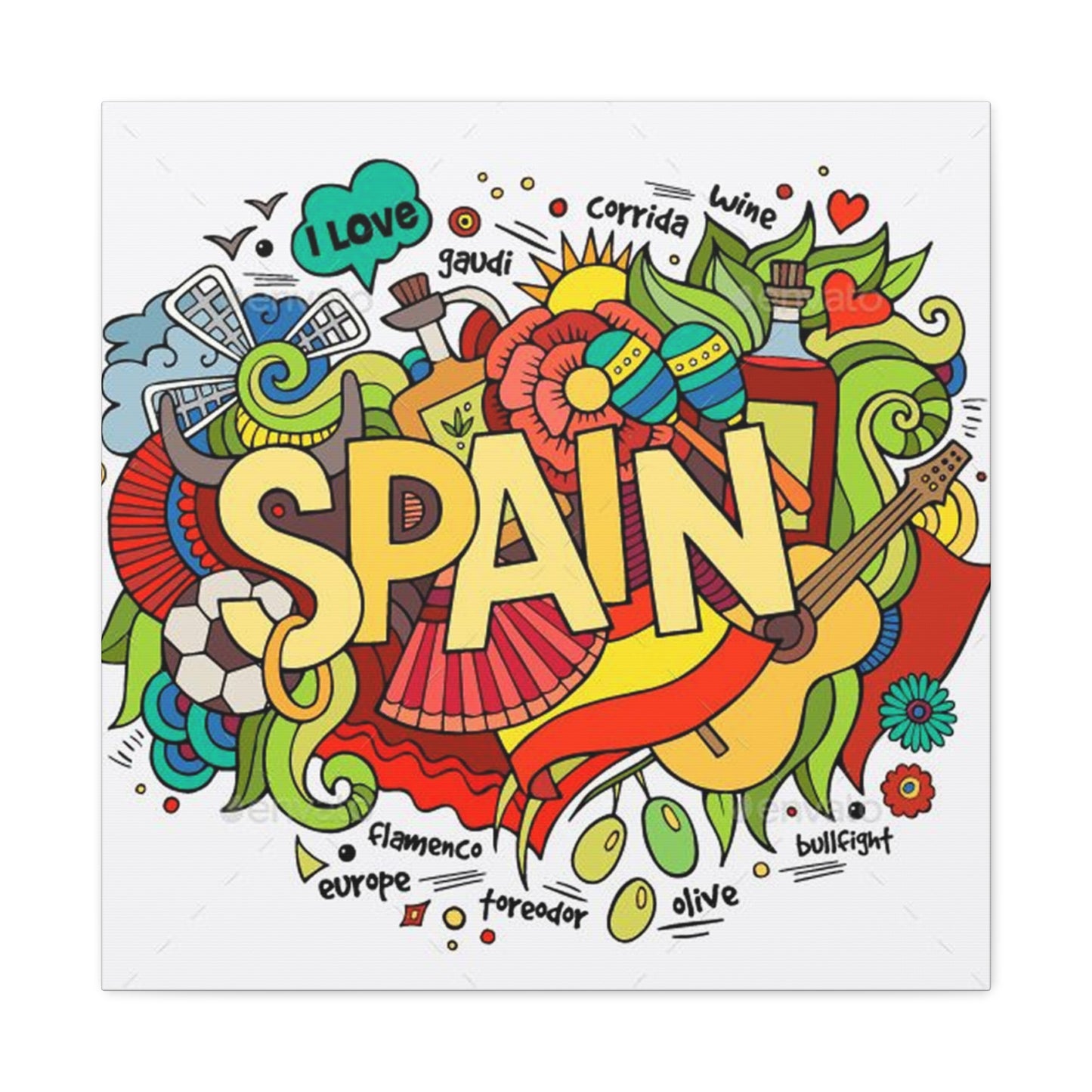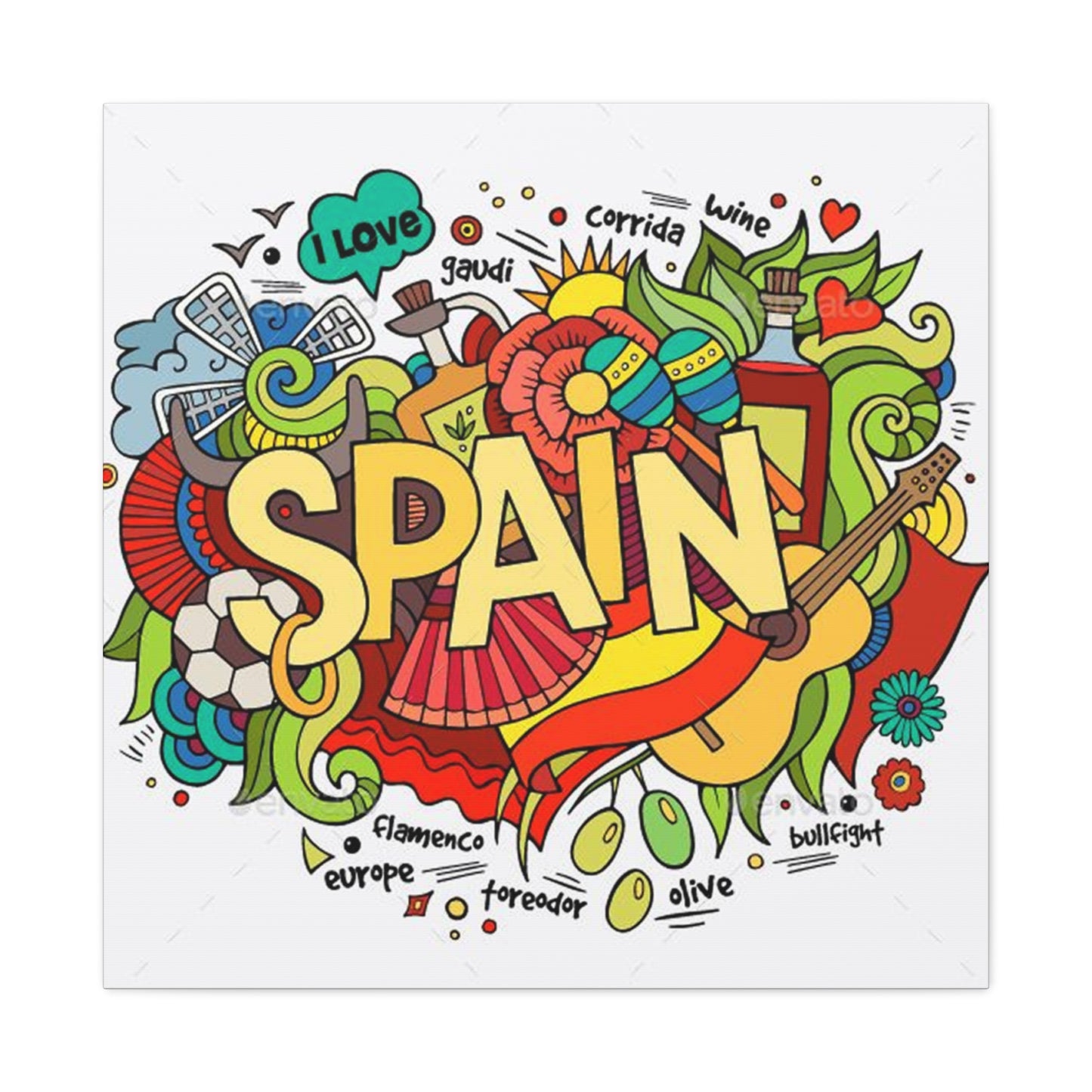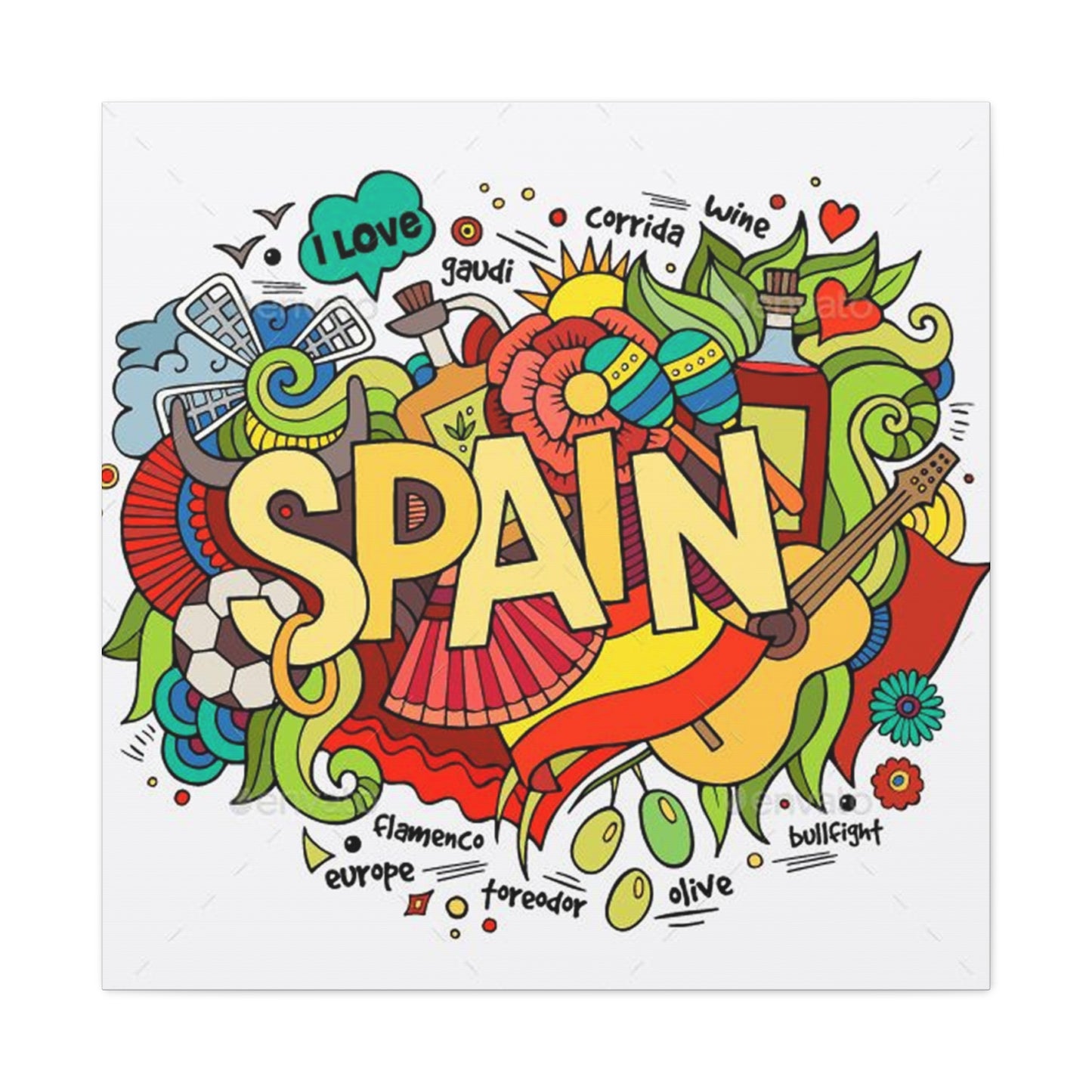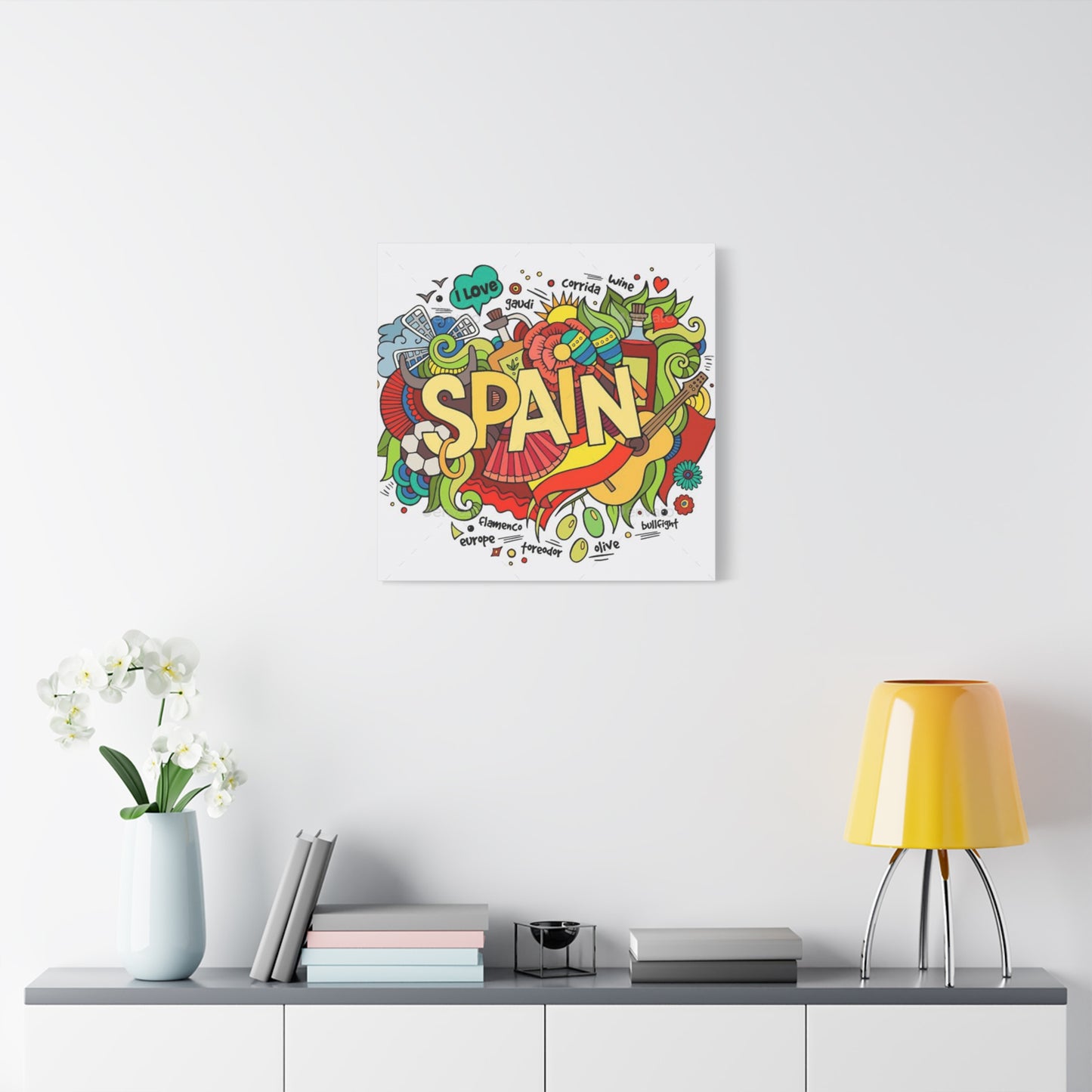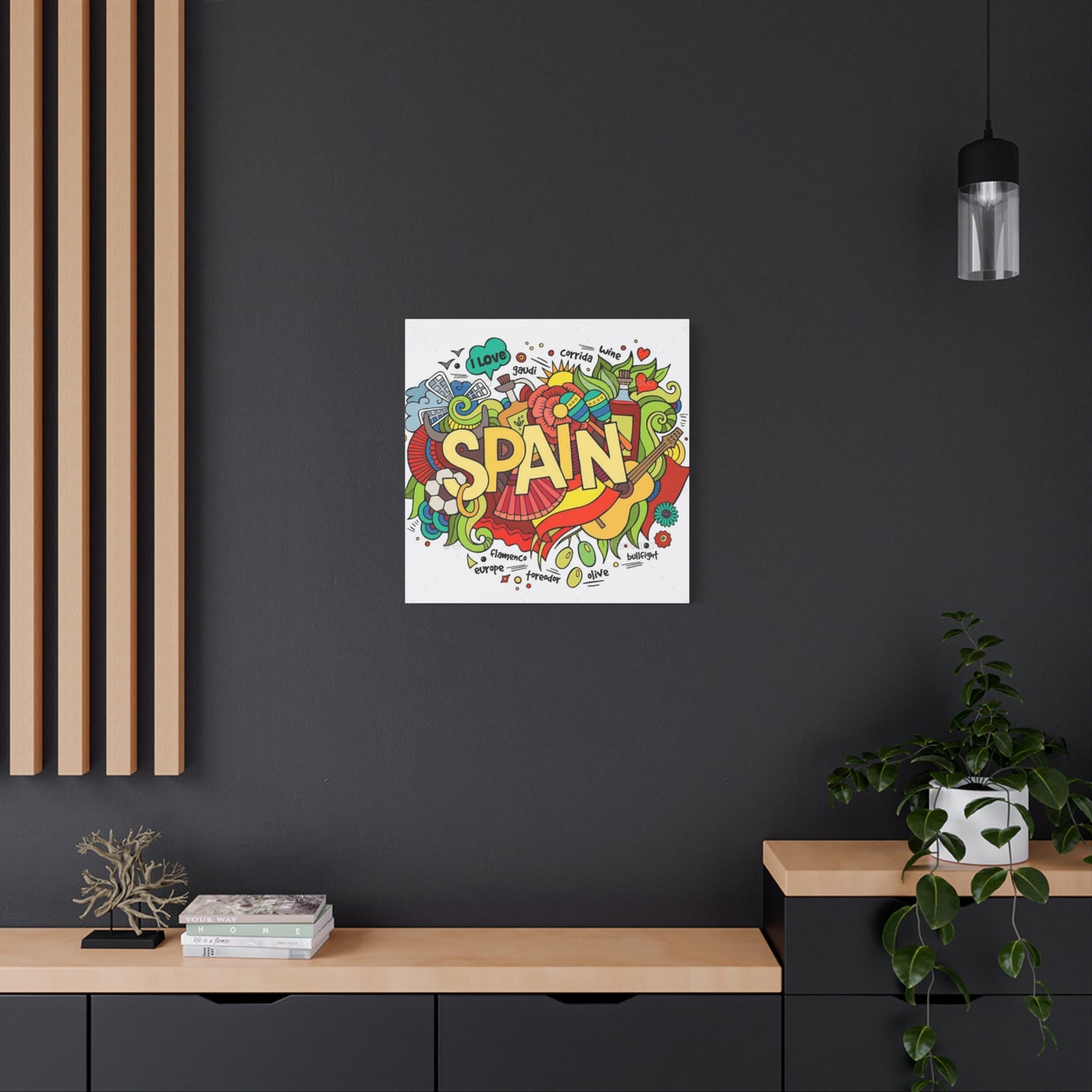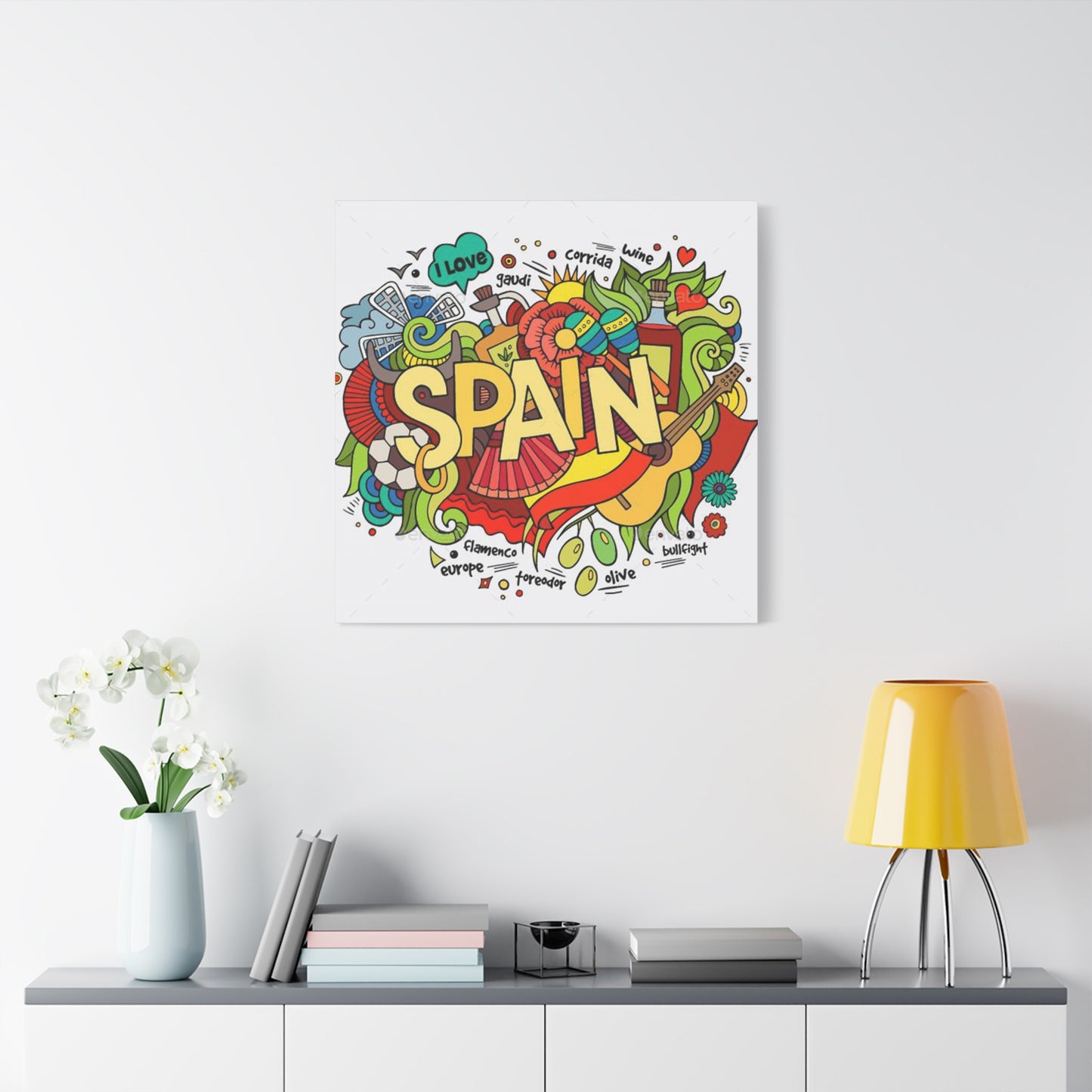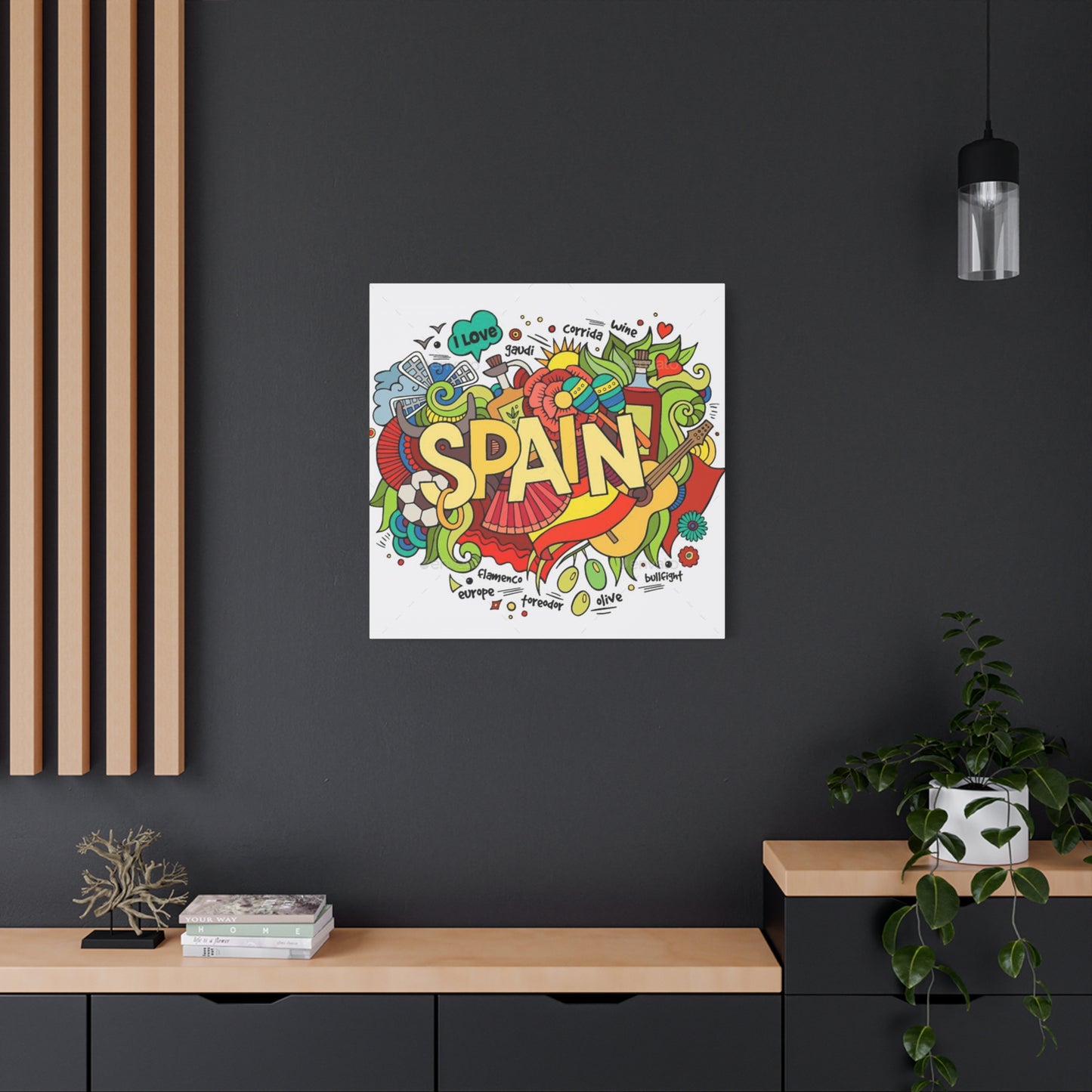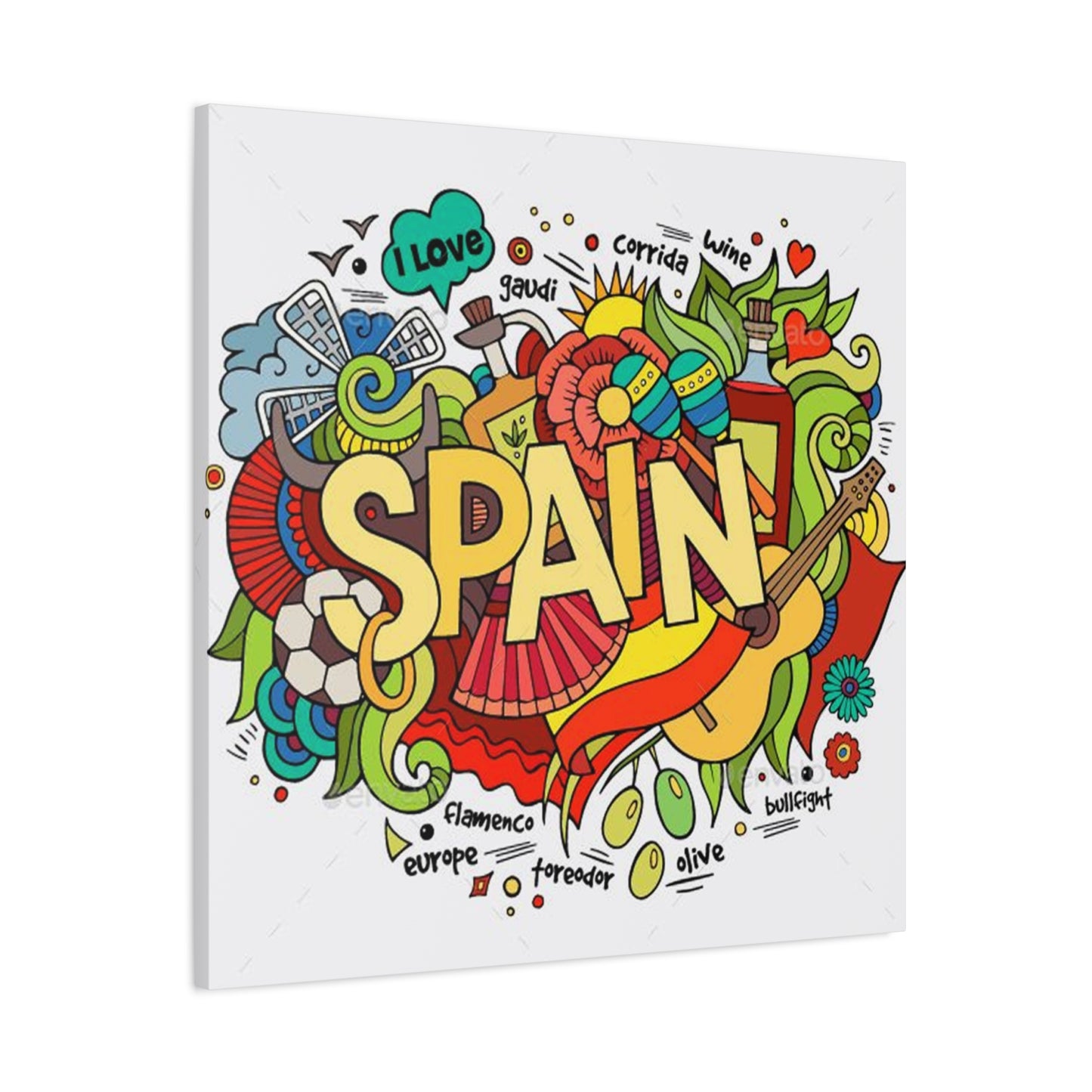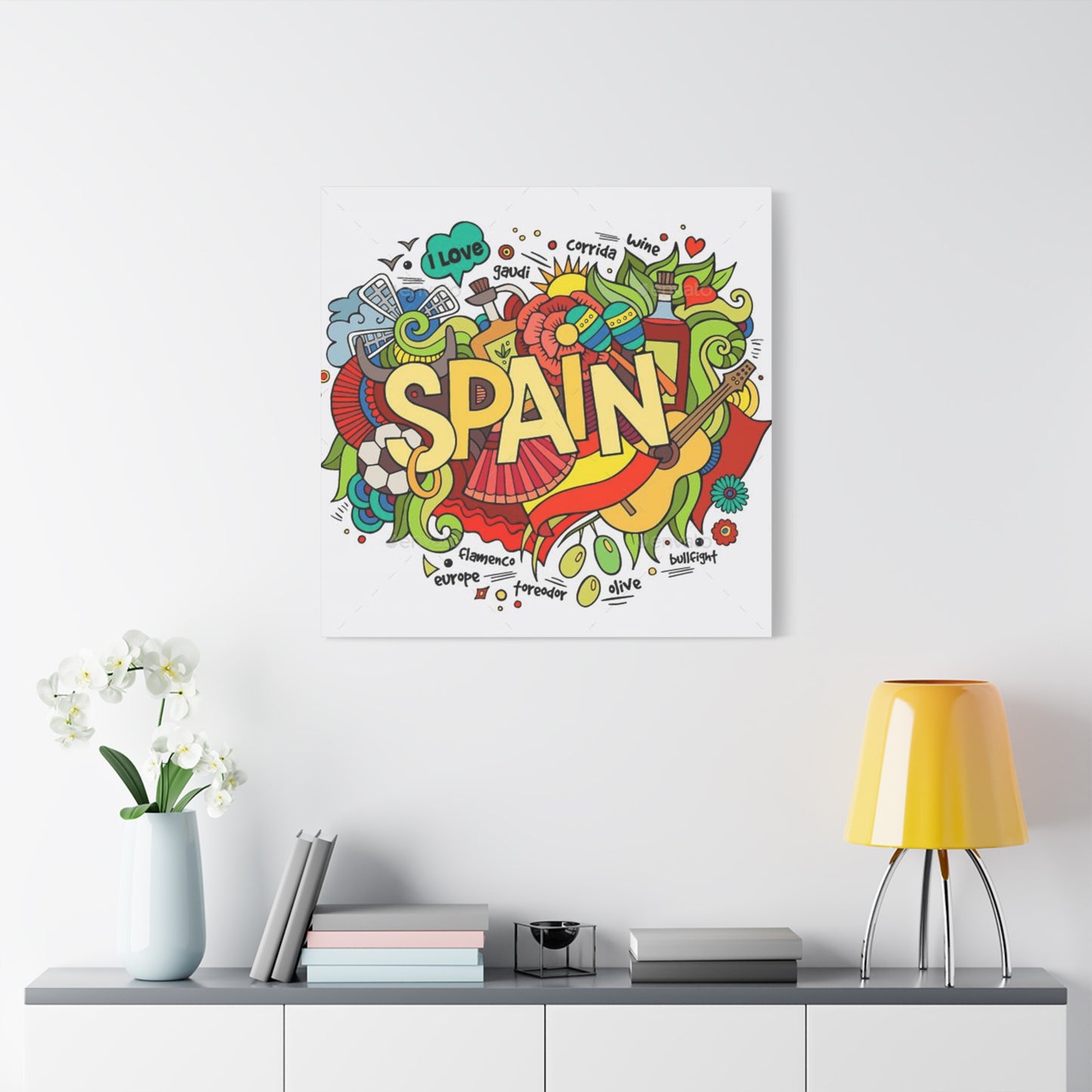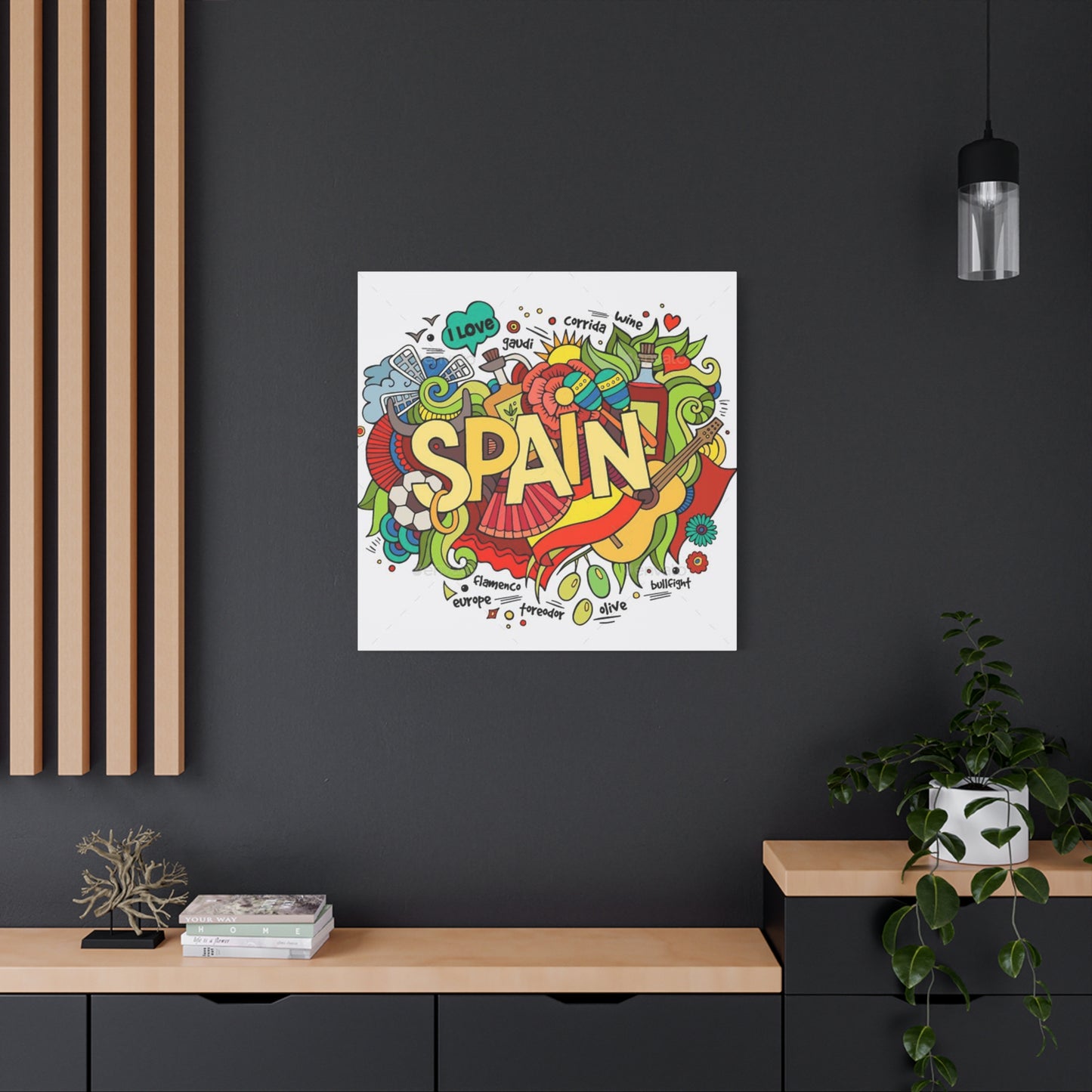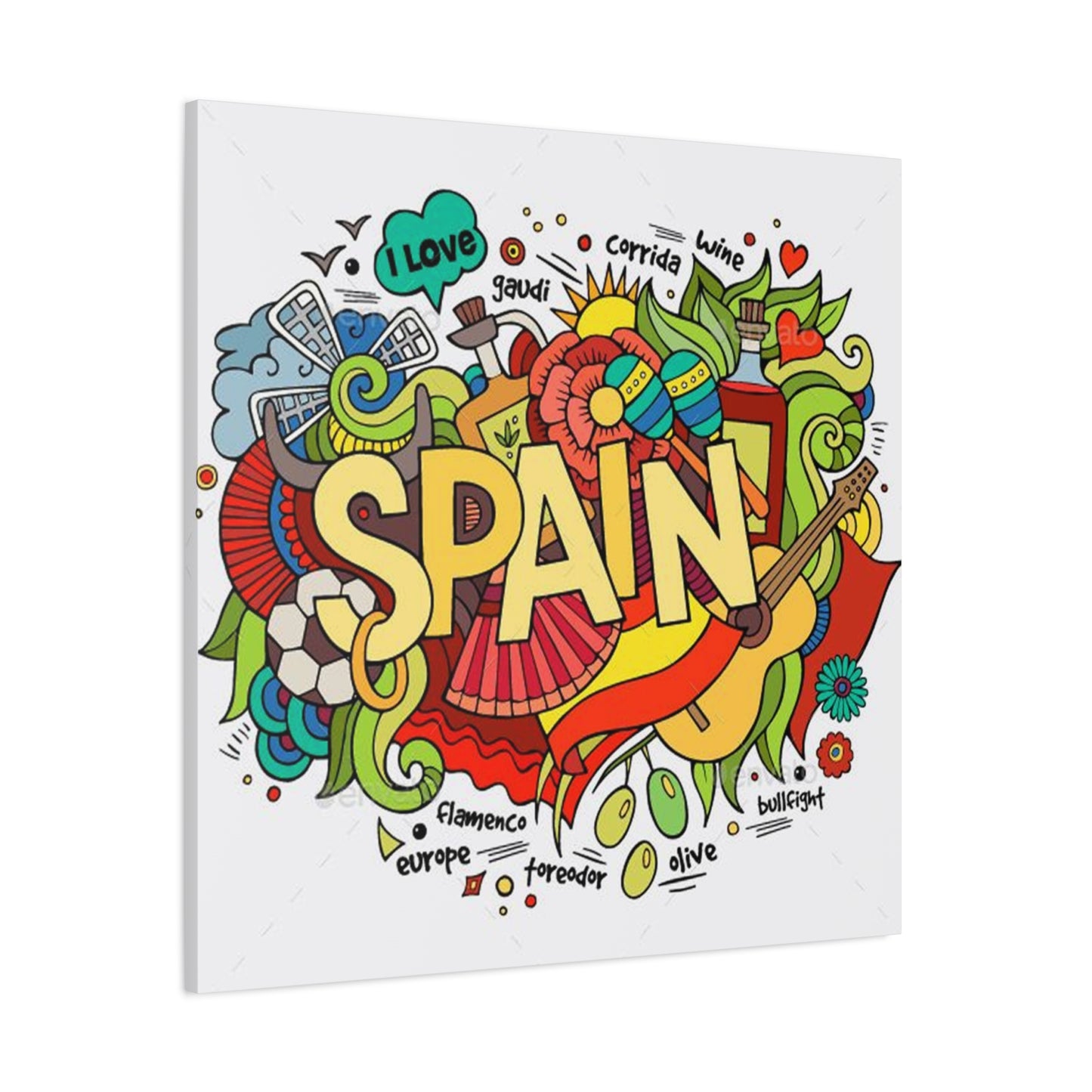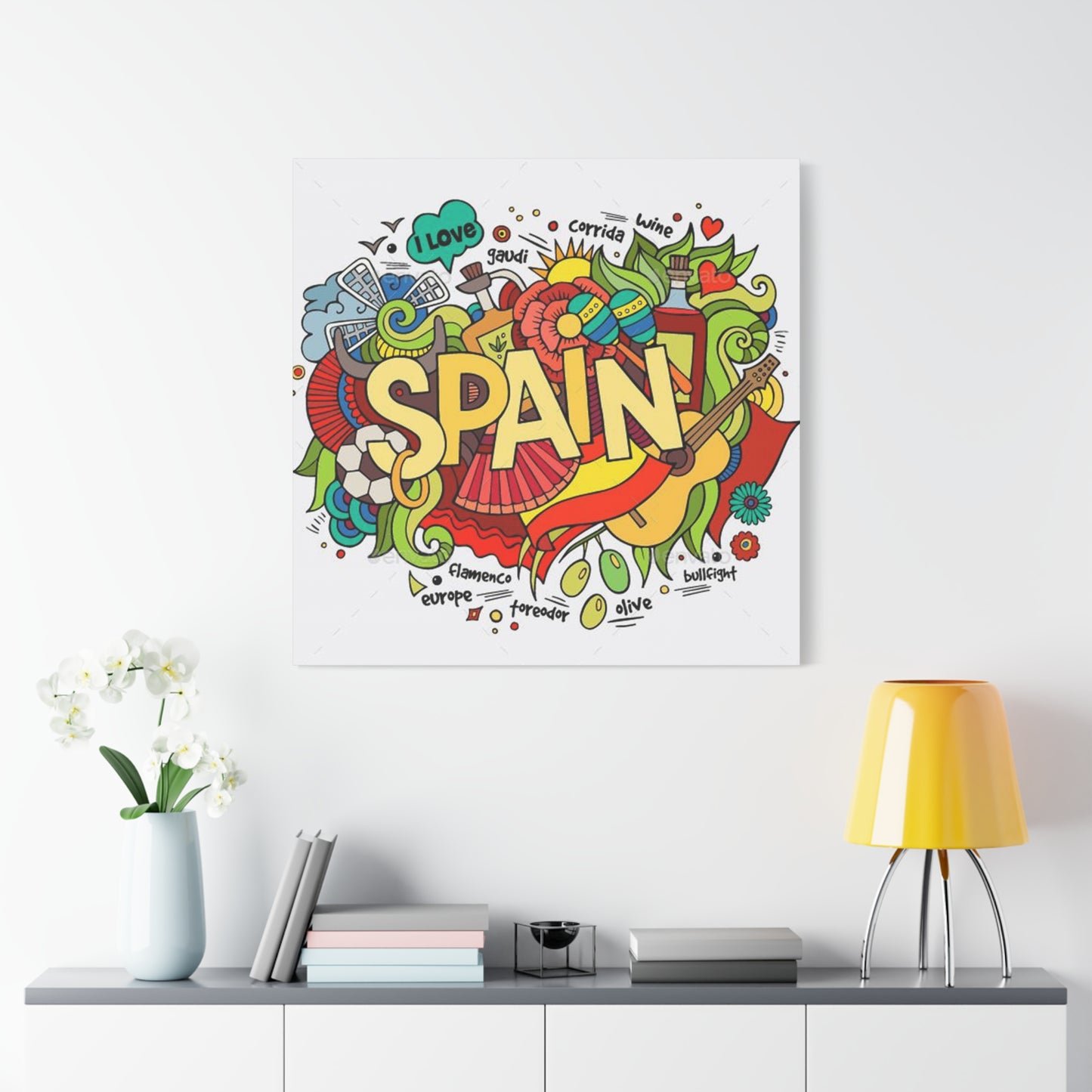Vibrant Spain Graffiti Wall Art: Your Complete Guide to Urban Street Art and Inspiring Décor
The phenomenon of vibrant Spain graffiti canvas has transformed the way contemporary society perceives both street art and interior design. What began as rebellious expressions on concrete walls has evolved into a sophisticated art form that commands attention in galleries, museums, and homes worldwide. The graffiti culture on canvas prints represents a significant shift in how artists approach visual storytelling through bold, dynamic, and emotionally resonant imagery. This comprehensive exploration delves into the multifaceted world of Spanish urban artistic expression, examining how these vibrant works continue to inspire interior design choices and cultural conversations globally.
The history of graffiti as an artistic movement cannot be separated from its deep roots in Spain, particularly in cities like Barcelona and Madrid where street style wall art prints have become defining cultural symbols. Artists working within this tradition have pushed boundaries, challenged conventional aesthetics, and created works that resonate with audiences of all backgrounds. The evolution from simple tags and throw-ups to elaborate, sophisticated pieces reflects the maturation of what many now consider a legitimate and celebrated art form. Spanish urban canvas inspiration has influenced countless artists worldwide, establishing Spain as a global epicenter for innovative and visually striking graffiti expression.
Exploring the Rich History of Spanish Graffiti Art Movements
The development of bold graffiti art for walls in Spain traces back decades, emerging from a cultural landscape rich with artistic tradition and social consciousness. Spanish cities became laboratories for experimentation, where artists tested new techniques, color combinations, and thematic approaches. The urban color captured in canvas representations showcases the evolution of artistic styles, from early minimalist approaches to complex, layered compositions that incorporate photorealism, abstraction, and social commentary. This historical progression has created a foundation upon which modern Spanish graffiti scenes on canvas continue to build and innovate.
Barcelona, in particular, established itself as a epicenter for progressive street art movements during the late twentieth century. Artists developed distinctive styles characterized by flowing lines, intricate details, and masterful use of color theory. The city's architectural landscape provided both canvas and inspiration, with its varied surfaces, building facades, and public spaces becoming venues for artistic expression. This environment fostered a community of dedicated artists who refined their skills, shared techniques, and continuously elevated the standards of their craft. The contemporary Spain wall art ideas that dominate modern discussions about interior design trace their conceptual lineage directly to these foundational periods.
Madrid emerged as another powerhouse in the Spanish graffiti universe, offering a different aesthetic approach while maintaining the same level of artistic excellence and innovation. The city's more geometric architecture and distinct urban rhythm influenced artistic choices, creating a recognizable Madrid aesthetic that differs from Barcelona's approaches. Artists working in Madrid developed their own signature styles, color palettes, and thematic preoccupations. This regional variation enriched the overall landscape of Spanish urban artistic expression, ensuring that modern reproductions and canvas adaptations could draw from diverse inspirational sources. The vibrant urban prints for interiors that grace contemporary homes often reflect these regional distinctions, providing collectors with opportunities to celebrate specific geographic artistic traditions.
The Contemporary Appeal of Urban Spanish Wall Prints
Modern appreciation for urban Spanish wall prints extends far beyond traditional graffiti enthusiasts or art world insiders. The democratization of these art forms through canvas reproductions has made them accessible to mainstream audiences seeking authentic, emotionally engaging visual experiences for their living spaces. Families, professionals, collectors, and design enthusiasts now actively seek Spanish street art wall inspiration for their homes, offices, and commercial establishments. This broader appeal reflects fundamental shifts in how society values artistic expression and recognizes the legitimacy of previously marginalized art forms.
The transition from street walls to canvas represents a meaningful evolution rather than a dilution of artistic integrity. Professional reproduction techniques now capture the vibrancy, texture, and emotional intensity of original works with remarkable fidelity. Advanced printing technologies preserve subtle color variations, layering effects, and technical nuances that define exceptional graffiti artistry. Collectors purchasing vibrant Spain graffiti canvas pieces receive not merely images but gateways into rich artistic traditions, cultural narratives, and the ongoing evolution of urban creative expression. The process of selecting and displaying these works in home environments becomes an act of cultural participation and aesthetic statement-making.
Interior designers increasingly incorporate bold and colorful canvas art into their professional projects, recognizing the visual impact and emotional resonance these pieces provide. Unlike conventional artwork that often serves decorative functions, graffiti-inspired canvas works engage viewers intellectually and emotionally, encouraging contemplation and conversation. The vivid Spanish street scenes captured on canvas function as focal points within rooms, commanding attention while simultaneously contributing to cohesive design schemes. Design professionals appreciate the versatility of these works, which complement contemporary, urban, industrial, eclectic, and transitional interior styles with equal effectiveness.
Decoding the Artistic Techniques Within Modern Graffiti Canvas Works
Understanding the technical sophistication underlying graffiti wall art for contemporary homes requires familiarity with the diverse methodologies employed by Spanish artists. These techniques have been refined through decades of practice, experimentation, and artistic evolution. Contemporary artists working within this tradition command skills encompassing aerosol spray painting, precision stenciling, brushwork integration, and digital collaboration. The mastery evident in finished works reflects not merely technical proficiency but deep artistic knowledge and intentional creative choices that elevate their creations beyond simple wall decoration.
Color theory occupies a central position within graffiti artistic practice, with Spanish artists demonstrating particular sophistication in their approach to hue selection, value relationships, and chromatic harmony. The consideration of complementary colors, saturation levels, and atmospheric perspective creates depth and visual excitement within compositions. Modern graffiti culture captured on canvas prints showcases this color mastery, with reproductions accurately representing the original artists' intentional choices regarding tone, contrast, and overall color impact. Viewers examining these works often find themselves struck by the harmonious relationships between seemingly diverse color selections, revealing the sophisticated understanding underlying these creative decisions.
Composition represents another essential technical consideration within the graffiti artistic tradition. Despite the spontaneous reputation often associated with street art, most accomplished Spanish graffiti culture works demonstrate careful structural planning and deliberate spatial arrangement. Artists consider balance, focal points, visual flow, and negative space relationships with the same intentionality that guides traditional fine artists. The sophisticated compositional approaches evident in Spanish urban canvas inspiration pieces reveal the depth of artistic thinking that informs even brief, energetic creative moments. This compositional sophistication distinguishes professional graffiti work from less accomplished attempts and explains why certain pieces continue to resonate and inspire across decades.
Exploring Regional Variations in Spanish Urban Artistic Expression
The geographic diversity within Spain has fostered distinct regional graffiti traditions, each characterized by particular aesthetic preferences, technical approaches, and thematic preoccupations. Catalan artists working in Barcelona developed distinctive styles reflecting the region's architectural heritage, cultural identity, and artistic traditions. Their work often incorporates flowing, organic forms alongside geometric precision, creating visually complex compositions that reward extended viewing. The Catalan approach to color frequently emphasizes vivid, almost jewel-like tones applied with careful consideration for interaction and contrast. Modern artistic Spain canvas wall décor inspired by these regional traditions carries forward these aesthetic commitments while introducing contemporary reinterpretations.
Andalusian artistic traditions introduced distinct elements into the broader Spanish graffiti landscape, bringing influences from Islamic art, traditional Spanish decorative practices, and the region's unique cultural heritage. Artists working within this context often developed more ornamental approaches, incorporating intricate patterns alongside figurative elements. The marriage of decorative sophistication with contemporary graffiti techniques created hybrid aesthetics that reflected the region's complex historical and cultural narrative. Modern reproductions featuring Andalusian-influenced Spanish street art wall inspiration provide viewers with opportunities to engage with these distinctive regional traditions within contemporary domestic settings.
Valencia and Bilbao emerged as additional significant centers for artistic innovation, each developing recognizable approaches to urban creative expression. Valencia's Mediterranean influence and cosmopolitan character produced artists willing to experiment with diverse thematic content and technical approaches. Bilbao's industrial heritage and social consciousness fostered graffiti works often addressing contemporary social issues while demonstrating technical mastery and visual sophistication. The existence of multiple regional traditions ensures that collectors and design enthusiasts exploring bold and colorful canvas art from Spain encounter diverse inspirational options rather than monolithic artistic approaches. This diversity enriches contemporary interior design possibilities while celebrating Spain's regional artistic distinctiveness.
The Emotional Language of Vibrant Urban Canvas Art
Graffiti art, regardless of geographic origin, fundamentally functions as a language of emotion and expression. Spanish artists have become particularly skilled at translating complex emotional states, social commentary, and philosophical concepts into visually powerful compositions. The vibrant hues, dynamic compositions, and technical mastery employed in these works create immediate emotional impact that transcends language barriers and cultural differences. Viewers encountering Spanish urban vibes through graffiti work on canvas frequently report feeling moved, energized, or provoked to deeper contemplation. This emotional resonance explains why homes incorporating bold graffiti art for walls often feel more dynamic, engaging, and personally meaningful than spaces decorated with conventional artwork.
The relationship between color and emotion operates particularly powerfully within graffiti artistic practice. Warm colors like reds, oranges, and yellows evoke feelings of energy, passion, and optimism, frequently dominating compositions meant to inspire and invigorate. Cool colors including blues, purples, and greens create calming effects or convey melancholy and introspection. Spanish artists working with vibrant Spain graffiti canvas demonstrate sophisticated understanding of these color-emotion relationships, employing them strategically to enhance compositional intentions. The resulting works function almost as emotional translations, allowing viewers to experience abstract feelings through tangible visual form. Interior spaces incorporating these emotional communication tools become environments where residents feel more aligned with their emotional needs and desires.
Identifying Quality and Authenticity in Contemporary Graffiti Canvas Reproductions
Discerning collectors and design professionals investing in bold wall prints from Spanish artists should understand the characteristics distinguishing superior reproductions from inadequate alternatives. Authentication begins with research regarding original artists, their verified works, and established artistic legacies. Reputable reproduction sources maintain detailed documentation connecting canvas prints to specific original works, artists, and creation contexts. This transparency builds confidence in the authenticity and artistic legitimacy of reproductions. Quality canvas prints demonstrate faithful color accuracy, capturing the vibrancy and nuance of original compositions rather than producing flat or washed-out representations. Professional reproductions employ archival-quality materials ensuring longevity and preservation of visual impact across years and decades.
The tactile qualities of superior graffiti wall art for contemporary homes merit careful consideration. High-quality reproductions often incorporate canvas texturing and layering techniques that approximate the physical presence of original street works. Some professional reproductions employ contemporary technical approaches to create depth, dimensionality, and surface variation that enhance viewer engagement. Understanding the distinction between basic flat reproductions and sophisticated multi-layered versions helps collectors make informed decisions aligned with their aesthetic preferences and budget considerations. The investment in superior reproductions pays dividends through years of visual pleasure and conversation-generating impact.
Framing and mounting choices significantly influence how viewers perceive and engage with Spanish urban canvas inspiration. Simple, minimalist framing often serves contemporary compositions exceptionally well, avoiding distraction and maintaining focus on artistic content. Conversely, certain works benefit from more elaborate presentation approaches that honor artistic traditions and thematic content. Professional framers specializing in graffiti-inspired artwork understand these nuances and can guide collectors toward presentation decisions enhancing overall visual impact. The relationship between artwork, frame, wall color, and surrounding furnishings creates a comprehensive aesthetic environment rather than isolated visual moments. Thoughtful presentation elevates displayed works from mere decoration to meaningful environmental design elements.
Thematic Content Within Spanish Graffiti Art Traditions
Contemporary vibrant Spain graffiti canvas works showcase remarkable thematic diversity, addressing topics ranging from pure abstraction to explicit social commentary. Many Spanish artists create works celebrating joy, celebration, and the transformative power of artistic expression. These pieces typically feature explosive color combinations, dynamic compositions, and figurative elements conveying positive emotional messaging. Their presence within interior spaces contributes to environments promoting happiness, inspiration, and creative thinking. Families with children particularly appreciate these affirming, life-celebrating works that embody optimism and artistic vitality.
Other Spanish street art wall inspiration pieces address more complex thematic terrain, exploring social justice, environmental concerns, and political critique. These works frequently incorporate symbolic imagery, textual elements, and compositional strategies that demand active viewer interpretation. Rather than providing comfortable viewing experiences, such pieces provoke thought, challenge assumptions, and encourage critical reflection. Interior designers working with politically or socially conscious clients often integrate these more challenging works, creating spaces that reflect inhabitants' values and intellectual commitments. The presence of socially engaged artwork demonstrates that residential environments need not remain neutral, apolitical spaces but can serve as platforms for meaningful expression.
Abstract compositions constitute another significant thematic category within graffiti artistic traditions. Spanish artists working with non-representational approaches focus on pure visual elements, exploring color relationships, compositional dynamics, and viewer psychological response through abstract means. These works appeal particularly to viewers seeking artistic expression divorced from literal imagery or specific narrative content. The freedom from representational constraints allows artists to pursue increasingly sophisticated explorations of visual relationships and formal properties. Modern Spain street art prints featuring abstract approaches integrate seamlessly into diverse interior design contexts while providing intellectual engagement and aesthetic pleasure.
Urban Color Captured in Canvas: The Science of Pigmentation and Reproduction
The visual impact of vibrant urban prints for interiors depends fundamentally on accurate color reproduction and sophisticated pigmentation technology. Contemporary printing methodologies employ advanced color calibration systems ensuring that reproductions faithfully represent original artworks' chromatic intentions. Digital imaging captures original compositions, and professional printing equipment applies pigmented inks with precision, building color layers that approximate aerosol paint effects. Understanding these technical processes helps collectors appreciate the sophistication underlying contemporary reproduction techniques and justifies investment in professionally produced works.
Color stability represents another crucial technical consideration within graffiti canvas print production. Archives quality pigments and archival canvas substrates resist fading, discoloration, and degradation across years of display. Professional reproduction sources typically guarantee color stability for extended periods, often specifying minimum longevity standards. This commitment to permanence ensures that bold and colorful canvas art remains vibrant and visually striking throughout its lifespan, maintaining aesthetic impact and emotional resonance. Cost considerations merit evaluation in light of longevity, as superior archival quality justifies higher initial investment through extended visual utility.
The relationship between lighting conditions and color perception significantly influences how graffiti wall art displays within specific interior environments. Natural light variations throughout the day create dynamic viewing experiences, with colors appearing different under morning, afternoon, and evening illumination conditions. Artificial lighting choices including color temperature and intensity similarly affect perceived colors. Thoughtful lighting design enhances artistic appreciation, emphasizing compositional elements and color relationships while avoiding glare or shadows obscuring visual content. Design professionals specializing in contemporary interior spaces often integrate sophisticated lighting strategies specifically to optimize artwork visibility and impact.
The Evolution of Digital Technology in Modern Graffiti Artistic Expression
Spanish urban vibes increasingly reflect technological integration, with contemporary artists employing digital tools alongside traditional aerosol techniques. Digital design platforms allow artists to experiment with compositions, color combinations, and conceptual approaches before executing physical works. This integration of digital and analog methods produces increasingly sophisticated artistic outcomes combining the spontaneity and energy of traditional graffiti with the precision and revision possibilities of digital tools. The resulting works often display technical complexity and conceptual sophistication reflecting the merged methodologies underlying their creation.
Contemporary graffiti culture on canvas prints frequently showcases works incorporating digital elements or created partially through digital processes. The acceptance of these hybrid approaches reflects broader artistic communities' recognition that artistic legitimacy derives from creative vision and technical excellence rather than adherence to specific medium requirements. Digital printing technologies themselves represent a form of technological mediation within contemporary artistic practice, translating original works into canvas formats through sophisticated mechanical and chemical processes. The entire ecosystem surrounding graffiti artwork reproduction involves technological systems ensuring faithful reproduction and physical preservation.
Social media platforms have fundamentally transformed how Spanish street art wall inspiration circulates and gains visibility. Artists photograph works, share images digitally, and build followings through online platforms. This expanded distribution dramatically increases artwork visibility while creating commercial opportunities for reproductions and professional recognition. The democratization of artistic promotion allows emerging artists to gain recognition independent of traditional gallery systems or institutional gatekeeping. Collectors now discover bold graffiti art for walls through social media platforms, often developing relationships with artists and making informed purchasing decisions based on digital communication and image sharing.
Selecting Appropriate Spanish Urban Canvas Works for Specific Interior Environments
Design professionals and homeowners choosing vibrant Spain graffiti canvas pieces must consider multiple factors including existing décor styles, room dimensions, lighting conditions, color schemes, and personal aesthetic preferences. Contemporary minimalist interiors often benefit from bold graffiti-inspired artwork that provides visual excitement and chromatic intensity against neutral backdrops. Industrial or urban-themed spaces naturally complement graffiti-inspired works, creating cohesive design environments that celebrate artistic traditions underlying the aesthetic approach. Eclectic interiors with diverse furnishings and varied color schemes can accommodate bolder, more experimental graffiti works, allowing multiple artistic voices to coexist within unified environments.
Room functionality influences artwork selection, as different spaces demand varying aesthetic approaches. Living areas incorporating graffiti art typically feature works emphasizing energy, creativity, and positive emotional messaging. Bedrooms might incorporate calmer, more contemplative pieces, potentially abstract compositions or works with cooler color palettes promoting relaxation. Home offices benefit from inspiring, energizing artwork that stimulates creative thinking and problem-solving capacity. Commercial spaces including offices, restaurants, and retail establishments often employ Spanish street art wall inspiration to create memorable, distinctive environments that reflect organizational values and attract customer engagement.
Scale relationships between artworks and surrounding architectural elements merit careful consideration. Large-scale graffiti canvas prints create dramatic focal points commanding attention within expansive rooms with substantial wall space. Conversely, smaller works function as accent pieces or gallery wall components within more intimate spaces. Understanding these spatial relationships prevents the common design error of selecting artwork inappropriately scaled for available wall area. Professional designers develop systematic approaches to scale evaluation, considering ceiling heights, wall widths, and surrounding furnishings when recommending specific artworks.
Budget Considerations and Investment Perspectives on Graffiti Canvas Acquisitions
Collectors approaching Spanish urban canvas inspiration acquisitions often wonder about appropriate budget allocation and value retention potential. Price variations within graffiti-inspired canvas prints reflect multiple factors including reproduction quality, canvas size, framing sophistication, artist recognition, and whether works derive from documented original pieces or contemporary artistic creations. Entry-level reproductions provide accessibility for budget-conscious collectors while still offering authentic connection to graffiti artistic traditions. Premium reproductions employing superior materials, limited production runs, and sophisticated reproduction techniques justify higher investment for collectors prioritizing exceptional quality and potential appreciation value.
Authentication and provenance considerations impact valuation within reproduction markets. Limited edition prints with certificate documentation and artistic attribution typically command higher prices than mass-produced alternatives. Collectors viewing graffiti-inspired canvas works as investment pieces should research artists, verify production credentials, and understand reproduction limitations and production quantities. While graffiti art reproductions generally appreciate more slowly than original works, certain limited editions and pieces by internationally recognized artists have demonstrated strong appreciation potential. Conservative collectors prioritizing stability over aggressive appreciation typically find graffiti canvas acquisitions secure investments returning aesthetic pleasure regardless of financial performance.
Commercial enterprises including galleries, interior design firms, and professional reproduction services offer investment opportunities for collectors seeking portfolio diversification. These ventures capitalize on growing mainstream acceptance of graffiti art while providing collectors access to curated, professionally authenticated works. Partnership arrangements between collectors and commercial entities sometimes provide preferential access to significant pieces before public availability. Understanding these market dynamics helps sophisticated collectors identify opportunities for advantageous acquisitions while building comprehensive collections reflecting particular artistic interests or thematic preoccupations.
Creating Cohesive Aesthetic Environments Through Thoughtful Artwork Integration
Modern interior design recognizes that individual artworks function most effectively within comprehensive environmental contexts rather than isolation. Bold and colorful canvas art serves as environmental design components contributing to overall aesthetic narratives and emotional atmospheres. Successful integration requires understanding how graffiti-inspired pieces interact with paint colors, furnishings, lighting, flooring materials, and architectural features. Color theory principles guide these decisions, with graffiti artwork colors informing broader palette selections or contrasting strategically with existing environmental color schemes. Designers working with contemporary Spain wall art ideas often develop comprehensive design schemes reflecting unified aesthetic visions.
Texture represents another crucial environmental design consideration complementing graffiti artwork integration. Vibrant urban prints for interiors often feature bold graphic qualities that interact powerfully with varied architectural textures. Smooth concrete walls, exposed brick, textured drywall, and architectural features including exposed beams create dynamic backdrops for displayed artwork. The interplay between artwork graphic intensity and environmental texture creates visual richness and environmental depth. Sophisticated designers exploit these textural interactions intentionally, creating spaces where multiple sensory and aesthetic dimensions contribute to unified experiences.
Spatial flow within interior environments benefits from thoughtful artwork placement strategies. Graffiti canvas pieces positioned at natural viewing points along traffic patterns receive maximum exposure and engagement. Stairwells, hallways, entryways, and rooms' focal wall areas provide ideal locations for artwork that commands attention and sets environmental tone. Conversely, subtle placement within less prominent locations creates surprising discoveries for attentive observers, rewarding careful environmental exploration. Design narratives often emerge through sequential artwork encounters, with different pieces contributing complementary messages as inhabitants move through spaces.
The Commercial Integration of Graffiti Aesthetics Into Contemporary Business Environments
Corporate offices increasingly incorporate Spanish street art wall inspiration, recognizing the creative stimulation and employee engagement these environments support. Design professionals working within commercial contexts employ bold graffiti-inspired artworks to create distinctive, memorable workplace environments reflecting organizational creativity and innovation values. Employees working within spaces featuring vibrant urban prints for interiors frequently report heightened engagement, improved mood, and enhanced creative thinking. This productivity correlation justifies corporate investment in graffiti-inspired environmental design despite initial skepticism from more traditional business contexts.
Hospitality industries including hotels, restaurants, and entertainment venues enthusiastically embrace graffiti wall art for contemporary environments. These establishments recognize that distinctive, visually striking spaces create memorable guest experiences while communicating organizational personality and values. Boutique hotels feature graffiti-inspired artwork as design elements distinguishing properties from corporate chains and creating authentic local character connections. Restaurants incorporate vibrant Spain graffiti canvas elements that energize dining environments and support social media sharing as guests photograph distinctive visual elements. The commercial success of graffiti-integrated hospitality spaces demonstrates mainstream market appeal extending well beyond traditional art enthusiast audiences.
Retail enterprises employ graffiti artistic elements to create engaging shopping environments encouraging extended customer visits and increased purchase engagement. Clothing retailers, music venues, and youth-oriented businesses particularly embrace graffiti aesthetics reflecting target audience preferences and organizational identity. The visual excitement and contemporary relevance of these environments align with consumer expectations for distinctive, emotionally engaging retail experiences. Strategic artwork placement functions as visual merchandising, directing customer attention toward featured products while enhancing overall environmental appeal. This commercial application demonstrates graffiti artistic integration's broad applicability across diverse business contexts.
Community and Cultural Significance of Spanish Street Art Movements
Beyond individual aesthetic appreciation, Spanish graffiti artistic traditions embody profound community and cultural significance reflecting broader social dynamics, historical narratives, and collective identity expression. Many graffiti artists view their work as community service, utilizing public spaces to address local concerns, celebrate cultural heritage, or amplify marginalized voices. These socially conscious artistic practices transform urban environments into platforms for democratic expression and collective participation. Communities recognizing this significance often protect and preserve exceptional graffiti works, designating official graffiti zones, establishing art festivals, and supporting artist development programs.
Tourism represents another significant cultural dimension of Spanish urban artistic expression. International visitors specifically travel to cities like Barcelona and Madrid to experience authentic graffiti scenes, photograph striking works, and engage with local artistic communities. This tourism generates economic activity benefiting local economies while creating cultural exchange opportunities. Visitors purchasing vibrant Spain graffiti canvas pieces carry artistic traditions internationally, establishing global appreciation networks and expanding recognition of Spanish artistic contributions. The tourism industry increasingly recognizes graffiti artistic heritage as cultural asset deserving preservation and celebration rather than dismissal as urban decay.
Educational institutions increasingly incorporate graffiti artistic traditions into curricula, recognizing their significance as legitimate art forms embodying important cultural narratives. Art students study Spanish graffiti techniques, artistic movements, and cultural contexts, developing sophisticated understandings of contemporary artistic expression. This institutional recognition legitimizes graffiti art within academic contexts while exposing younger generations to artistic traditions previously dismissed or denigrated. Museums and cultural institutions curate graffiti-focused exhibitions, establishing permanent collections and organizing scholarly programming. This institutional validation represents remarkable transformation in how cultural authorities perceive and engage with graffiti artistic traditions.
Exploring Gender Dynamics Within Contemporary Graffiti Artistic Communities
Spanish graffiti scenes, like global street art movements, traditionally exhibited significant gender imbalances, with female artists often occupying marginalized positions within male-dominated communities. Contemporary developments reflect gradual but meaningful shifts toward greater inclusion and recognition of female artistic voices. Women artists working within graffiti traditions increasingly receive institutional recognition, commercial opportunities, and artistic respect comparable to male counterparts. Their artistic contributions showcase distinctive perspectives, thematic preoccupations, and technical innovations enriching broader artistic landscapes. Modern Spanish urban canvas inspiration increasingly celebrates female artistic voices, ensuring diverse representation within reproductions and gallery exhibitions.
Female-identified artists often employ graffiti platforms to address gender-specific concerns, feminist perspectives, and women's experiences within contemporary society. These thematic preoccupations introduce new content dimensions to graffiti artistic discourse while challenging traditional masculine associations with street art practices. Collectors and design professionals increasingly seek work by female artists, recognizing both artistic merit and ethical importance of supporting marginalized creators. The commercial success of female-identified Spanish graffiti artists demonstrates market demand for diverse artistic perspectives and commitment to more equitable artistic communities.
Intergenerational transmission of artistic knowledge within families increasingly involves female participation and mentorship. Established female artists actively mentor emerging practitioners, creating supportive communities and professional networks facilitating sustained artistic development. These mentorship relationships often emphasize collaborative rather than competitive artistic approaches, potentially reshaping broader graffiti cultural norms. Future developments will likely continue expanding female representation and influence within Spanish urban artistic traditions, creating increasingly balanced and diverse creative communities.
Sustainable Practices and Environmental Considerations in Contemporary Graffiti Production
Modern graffiti artistic practice increasingly integrates environmental consciousness, reflecting broader societal recognition of ecological imperatives. Artists experiment with eco-friendly paint formulations, non-toxic pigments, and sustainable substrate materials minimizing environmental impact. These conscious material choices extend graffiti traditions' environmental footprints beyond the obvious street practice dimensions to encompass reproduction and display processes. Collectors prioritizing environmental responsibility can seek graffiti canvas prints employing sustainable materials, archival conservation approaches, and responsible manufacturing processes.
The canvas production industry increasingly implements environmentally conscious practices addressing production waste, chemical usage, and resource consumption. Advanced printing technologies require less water and produce minimal chemical waste compared to historical printing methodologies. Natural dye development and pigment innovation continue expanding sustainable reproduction options for graffiti-inspired works. Progressive manufacturers transparently communicate environmental practices, allowing conscious consumers to align purchasing decisions with values. Investment in environmentally responsible graffiti art acquisition supports businesses and industries advancing sustainable cultural production practices.
Digital reproduction technologies represent significant environmental advancement over traditional printing methods, reducing material waste and resource requirements substantially. Artists utilizing digital tools before physical execution minimize failed attempts and wasted materials characteristic of traditional experimentation. This technological integration contributes to more efficient artistic processes with reduced environmental consequences. The collective impact of these incremental improvements translates into meaningful environmental benefits across the graffiti artistic ecosystem spanning creation, reproduction, and display dimensions.
Advanced Compositional Strategies Within Contemporary Spanish Graffiti Pieces
Sophisticated compositional analysis reveals that accomplished Spanish graffiti artists employ advanced visual strategies comparable to formal fine art training. Figure-ground relationships demonstrating mastery of positive and negative space management create visual complexity rewarding extended contemplation. Artists manipulate optical illusions and ambiguous spatial relationships, challenging viewers' perceptual assumptions and encouraging active engagement. These sophisticated compositional approaches distinguish accomplished graffiti work from simpler expressions, revealing the intellectual and technical depth underlying visual surface complexity.
Color gradient techniques and subtle tonal transitions create dimensionality and atmospheric perspective within ostensibly flat compositional planes. Spanish artists particularly demonstrate sophisticated grasp of color temperature variations and saturation management, creating perceived spatial recession and volumetric form through chromatic manipulation alone. These advanced color theory applications rival contemporary fine art sophistication while accomplishing objectives within graffiti medium constraints. Examining detailed reproductions of these works reveals compositional nuances often imperceptible in distant street viewing, rewarding close observation with visual discoveries and technical appreciation.
Layering and transparency effects achieved through overlapping elements and color interaction create complex visual environments within single compositions. Some Spanish artists incorporate deliberately illegible elements, gestural marks, or textural variations that enhance overall impact despite resisting clear interpretation. These compositional choices reflect mature artistic perspectives recognizing that visual sophistication transcends clarity and demands comfortable viewer tolerance for ambiguity and complexity. Modern appreciation of graffiti-inspired canvas works increasingly embraces these sophisticated approaches, moving beyond demands for obvious meaning or narrative clarity.
Thematic Exploration of Identity and Cultural Expression in Spanish Graffiti
Many Spanish graffiti artists deliberately engage identity exploration, utilizing artistic platforms to interrogate questions of personal, cultural, and national identity. These works address complex themes including immigration, globalization, cultural preservation, and individual self-determination. The resulting artistic expressions translate abstract identity questions into tangible visual forms creating accessible engagement points for viewers contemplating similar themes. Collectors purchasing vibrant Spain graffiti canvas pieces embodying identity exploration acquire artworks functioning simultaneously as aesthetic objects and philosophical documents addressing contemporary social conditions.
Bilingual and multilingual text integration within graffiti compositions reflects Spain's linguistic diversity and artists' commitments to communicating across linguistic communities. Catalan, Spanish, Basque, and other linguistic traditions appear within artworks, asserting linguistic identity while expanding potential audience reach. Contemporary translation and interpretation resources allow international audiences to engage with textual content previously limited to local language speakers. This expanded accessibility democratizes artistic participation while celebrating linguistic pluralism and regional distinctiveness within broader Spanish cultural frameworks.
Regional cultural symbols and historical references frequently populate Spanish graffiti compositions, creating layers of meaning accessible primarily to audiences possessing local cultural knowledge. International viewers encountering these works engage on purely aesthetic levels while lacking deeper contextual understanding. This dynamic creates opportunities for cultural learning and cross-cultural exchange, with international audiences researching references, studying regional history, and developing sophisticated cultural understanding. Contemporary graffiti canvas displays often accompany educational materials providing this contextual information, enriching viewer experiences through knowledge transmission alongside aesthetic appreciation.
The Intersection of Graffiti Art and Fine Art Traditions in Contemporary Contexts
Contemporary art world recognition of graffiti as legitimate artistic expression has dissolved historical boundaries between street art and fine art traditions. Major museums worldwide now exhibit graffiti-inspired works alongside paintings, sculptures, and installations created within fine art contexts. This institutional integration validates graffiti artistic approaches while introducing new audiences to contemporary street art traditions. Spanish artists transition seamlessly between street work and gallery exhibition, expanding artistic reach and commercial viability while maintaining commitment to authentic artistic expression. This blurred boundary reflects mature artistic ecosystems recognizing quality and creative vision as primary legitimacy criteria independent of medium or creation context.
Art education increasingly incorporates graffiti artistic traditions within formal curricula alongside historical fine art study. Students studying contemporary art encounter graffiti works as significant artistic contributions deserving rigorous analysis and intellectual engagement. This educational integration ensures that future artists and cultural practitioners develop sophisticated understandings of graffiti's artistic legitimacy and cultural significance. Graduate-level art programs increasingly feature faculty specializing in graffiti traditions, establishing academic rigor around contemporary street art discourse. This institutionalization reflects final validation of graffiti's transformation from marginalized practice to mainstream artistic legitimacy.
Collaborative projects bridging graffiti and fine art traditions produce innovative hybrid works synthesizing distinct aesthetic approaches. Spanish artists partnering with gallery curators, museum professionals, and fine artists create works reflecting accumulated artistic traditions while introducing novel conceptual approaches. These collaborations expand both communities' artistic horizons while generating commercially viable products attracting diverse audience segments. The resulting works often occupy ambiguous categorical space, functioning simultaneously as graffiti-influenced contemporary art and fine art engaging street artistic traditions. This categorical ambiguity reflects productive artistic dynamism rather than conceptual confusion, demonstrating how mature artistic ecosystems transcend rigid categorical boundaries.
Practical Guidance for Installing and Maintaining Graffiti Canvas Artworks
Proper installation significantly impacts how graffiti-inspired canvas works appear within interior environments and how effectively they achieve aesthetic objectives. Professional installation ensures secure mounting, appropriate height positioning, and proper leveling creating polished presentation. Most canvas prints mount directly to walls using appropriate hardware selected according to substrate type and artwork weight. Heavy works require robust anchoring systems preventing accidental displacement or damage. Professional installers understand these technical requirements, preventing common errors including improper hardware selection or inadequate mounting infrastructure resulting in unsafe or aesthetically compromised presentations.
Environmental conditions surrounding displayed graffiti canvas pieces influence preservation and visual longevity. Excessive moisture, extreme temperature fluctuations, and direct sunlight exposure degrade canvas materials and accelerate pigment fading. Appropriate environmental controls including humidity management, temperature stability, and strategic lighting protect investments while maintaining aesthetic impact. Collectors housing particularly valuable or significant works often implement sophisticated environmental systems including humidifiers, dehumidifiers, and ultraviolet protective glass barriers. These preservation measures justify investment through extended artwork longevity and maintained visual quality across decades.
Routine maintenance preserves graffiti canvas print appearance and extends operational lifespan. Regular dusting prevents particulate accumulation affecting visual clarity. Gentle cleaning using non-abrasive, non-toxic materials removes environmental contaminants without damaging canvas or pigment. Periodic professional conservation assessment identifies emerging damage, fading, or degradation requiring professional attention. Insurance protecting valuable collections against theft, damage, or environmental disasters represents prudent investment for collectors possessing significant holdings. These preservation practices collectively ensure that modern Spain street art prints remain visually striking and structurally sound throughout extended display periods.
Collecting Graffiti Art: From Entry-Level to Connoisseurship
Collectors approaching Spanish urban wall art with limited experience benefit from structured development strategies building knowledge and appreciation gradually. Beginning collectors typically purchase reproductions of documented original works by recognized artists, establishing foundational understanding of artistic traditions and aesthetic approaches. Entry-level collecting develops visual literacy enabling discrimination between superior and inferior works, quality appreciation skills, and personal aesthetic preferences. Initial acquisitions often include works by commercially recognized artists with established market value and documented artistic legitimacy. These foundational collections provide comfortable learning environments for collecting development.
Intermediate collectors expand engagement through deeper research into artistic movements, regional traditions, and individual artist practices. This developmental stage often involves visiting galleries, attending exhibitions, purchasing artist monographs, and engaging with academic literature analyzing graffiti traditions. Collectors develop specialized interests within broader traditions, potentially focusing on particular regional schools, artistic periods, or thematic preoccupations. Intermediate collecting might include limited edition prints, museum-quality reproductions, or smaller original works by emerging artists. These acquisitions often involve higher financial commitment and require more sophisticated authentication and valuation expertise than entry-level purchases.
Advanced collectors participate actively within graffiti artistic communities, potentially developing direct relationships with artists, acquiring original works rather than reproductions, and building comprehensive collections reflecting sophisticated artistic understanding. Connoisseur-level collecting demands extensive knowledge, significant financial resources, and strong networks within professional art communities. Advanced collectors often publish writings, curate exhibitions, or otherwise contribute to broader cultural discourse surrounding graffiti traditions. Their acquisitions command premium pricing reflecting artistic rarity, institutional recognition, and market reputation. These collectors represent aesthetic authorities influencing broader market dynamics and artistic valuations through their collecting practices and public commentary.
Exploring Digital Media and Virtual Display Innovations for Graffiti Art
Contemporary technology innovations create novel opportunities for engaging with Spanish urban vibes through digital media platforms and virtual environments. High-resolution digital imagery enables viewers to examine graffiti canvas pieces at scales and viewing distances impossible in physical gallery contexts. Zoom functionality reveals compositional nuances and technical details, enriching appreciation and understanding. Digital reproductions democratize access, allowing global audiences to engage with works regardless of physical location or travel capacity. While digital media cannot fully replicate the sensory experience of in-person viewing, they provide meaningful alternatives that substantially expand artistic accessibility.
Virtual reality (VR) technologies take this engagement a step further by enabling immersive graffiti art experiences. Viewers can virtually explore street art locations, examine works from multiple angles, and appreciate the spatial context and environment surrounding the pieces—elements often lost in traditional photographs or gallery displays. This technology offers a unique opportunity to experience the dynamic urban atmosphere and cultural vibrancy that define graffiti art.
Moreover, augmented reality (AR) applications allow users to superimpose graffiti art onto their own physical spaces, blending real-world environments with digital creativity. These innovations not only preserve and showcase street art but also foster interactive, personalized experiences that engage wider and more diverse audiences.
Conclusion
In conclusion, Vibrant Spain graffiti wall art offers a dynamic and inspiring way to bring the spirit of urban creativity and cultural vitality into your living or working space. This form of street art, deeply rooted in the lively and colorful streets of Spain’s cities—such as Barcelona, Madrid, and Valencia—embodies the energy, passion, and bold self-expression that define contemporary urban culture. By incorporating graffiti-inspired pieces into your décor, you embrace a unique aesthetic that celebrates individuality, social commentary, and artistic innovation.
One of the most exciting aspects of Spanish graffiti wall art is its vivid use of color and movement. The intense hues, fluid lines, and striking contrasts commonly found in this art form create an immediate visual impact that enlivens any space. Whether it’s a sprawling mural or a carefully curated canvas print, the vibrant palette evokes the warmth of the Mediterranean sun and the rich cultural tapestry of Spain. This energetic aesthetic not only brightens walls but also sparks creativity and optimism, making your home or workspace a hub of inspiration.
Beyond its visual appeal, Spanish graffiti is a powerful medium of storytelling and social expression. Often addressing themes such as identity, politics, community, and resistance, graffiti art reflects the voices of diverse urban populations and their experiences. Integrating such art into your décor invites thoughtful reflection and dialogue, connecting your environment to broader cultural and social narratives. It’s a celebration of the urban spirit’s resilience and its capacity to transform public spaces into canvases of collective memory and hope.
Moreover, graffiti wall art offers incredible versatility in style and scale. From abstract, geometric designs and bold typographic statements to figurative works that capture human emotion and social issues, there’s a broad spectrum of expression within Spanish urban art. This diversity means that whether you prefer a subtle accent piece or a dramatic centerpiece, graffiti-inspired wall art can be adapted to suit your taste and space. The fusion of street edge with contemporary décor creates a fresh, modern look that appeals to both art enthusiasts and casual decorators.
Embracing vibrant Spain graffiti art also signifies a commitment to supporting local artists and urban culture. Many graffiti artists are deeply connected to their communities, using their talents to revitalize neighborhoods and foster social cohesion. Purchasing original pieces, limited edition prints, or collaborations with local creators helps sustain this vibrant art scene and promotes cultural sustainability. It’s a way to honor the authentic spirit of Spanish street art while enriching your décor with meaningful and ethically sourced artwork.
Additionally, graffiti wall art brings a sense of urban authenticity and boldness that challenges traditional ideas of what home décor can be. It pushes boundaries and encourages viewers to reconsider the role of art in everyday life—not confined to galleries or museums, but alive on city walls and now in personal spaces. This democratization of art invites inclusivity and celebrates creativity in its rawest, most accessible form. Bringing this energy into your home creates an environment that values expression, diversity, and innovation.
The influence of Spanish culture in graffiti also introduces elements of history, language, and symbolism that add depth and richness to your décor. From flamenco-inspired motifs and architectural references to regional dialects and cultural icons, these artworks weave a story that honors tradition while embracing modernity. This blending of past and present enriches the visual narrative and fosters a deeper connection to Spain’s multifaceted identity.
Ultimately, vibrant Spain graffiti wall art is more than just a design choice—it is a celebration of life, color, and community. It transforms walls into lively expressions of passion and creativity, inviting all who enter to engage with the energy and stories embedded in every stroke and splash of paint. This style brings urban culture indoors, making art accessible, relatable, and deeply personal.
By incorporating this form of street art into your home or workspace, you create a space that is not only visually striking but also culturally resonant and emotionally uplifting. It’s an opportunity to celebrate the fearless spirit of Spanish urban artists and to cultivate an environment where inspiration flows freely. Whether you’re a seasoned art lover or a newcomer to the world of graffiti, this vibrant aesthetic offers endless possibilities for self-expression and design innovation.

















